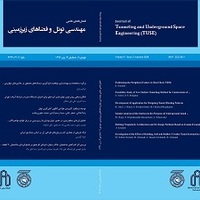Batter piles up to 45° inclination are used in some giant projects such as bridges, oil platforms, store pits, power plants, vertical car parks, and even some constructed buildings on poor soils. However, the effects of tunneling on the... more
Batter piles up to 45° inclination are used in some giant projects such as bridges, oil platforms, store pits, power plants, vertical car parks, and even some constructed buildings on poor soils. However, the effects of tunneling on the pile tip strength, buckling of piles and surface settlement are various. This research intends to study the stress-displacement behavior of surface ground during tunneling in vicinity of batter piles. Finite-element method (FEM) has been used to investigate the effect of position and inclination of the piles on the induced surface displacement. After validating and estimating the efficiency of the Finite element (FE) code, model development has been carried out by comparing the inclination in three degrees (10°, 20° and 30°) and three different lengths of the piles (15, 21 and 27 m). The results showed that in all the lengths and inclinations of piles, the maximum settlement of pile element is higher than the maximum surface settlement and it is higher than the maximum settlement of pile head.
An analytical solution for the evaluation of dynamic response of a tunnel in infinite isotropic elastic porous media is presented. Tunnel is considered as a circular cavity. Two groups of complex functions for solid skeleton and pore... more
An analytical solution for the evaluation of dynamic response of a tunnel in infinite isotropic elastic porous media is presented. Tunnel is considered as a circular cavity. Two groups of complex functions for solid skeleton and pore fluid in a two-dimensional (2D) complex plane are introduced in order to solve the Biot equations. Stress, displacement and pore pressure fields induced by incident and scattered waves in the medium and especially in the vicinity of the cavity are evaluated in this complex plane. The validation of the proposed solution is shown by various numerical examples. A parametric study including the effects of fluid compressibility changes, shear modulus and permeability variations, several wave numbers and wave types (fast, slow and shear waves) is performed.
This paper aims to use pushover analysis for performancebased seismic assessment of linings of shallow tunnels constructed in soil that are subjected to vertical shear waves. Pushover analysis is a nonlinear static analysis that works... more
This paper aims to use pushover analysis for performancebased seismic assessment of linings of shallow tunnels constructed in soil that are subjected to vertical shear waves. Pushover analysis is a nonlinear static analysis that works based on pushing laterally two-dimensional (2D) numerical nonlinear model of soil with tunnel statically. This analysis considers just ovaling/racking deformation of a lining and compared to the other existing seismic analysis approaches, it has the advantage of using directly a standard acceleration response spectrum as seismic demand. Initially in this paper, responses of a typical tunnel due to four earthquakes were calculated using pushover analysis. Then, the approach of employing a typical standard acceleration response spectrum as seismic demand was presented using the building standard spectrum of FEMA 302 provisions. All the resultant performance points of pushover analyses were then evaluated by carrying out nonlinear dynamic time history analyses and the method was verified. However, further studies are required to propose an acceptable response spectrum for the geotechnical nature of soil deposits containing shallow tunnels as their seismic demand.
